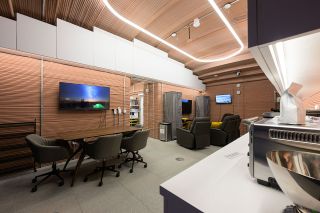Home
News
Spaceflight

Inside Mars Dune Alpha, a 3D-printed mock Mars base at NASA’s Johnson Space Center in Houston, Texas.
(Image credit: NASA)
It’s been a week since NASA locked four people inside a mock Mars habitat for the next year and we’ve just received our best glimpse yet at what life inside the simulated space base is like.
Located at NASA’s Johnson Space Center, in Houston, Texas, the 3D-printed mock-Martian base, known as Mars Dune Alpha, is the home of the agency’s first-ever Crew Health and Performance Exploration Analog (CHAPEA) mission for crewmembers Kelly Haston, Ross Rockwell, Nathan Jones and Anca Selariu for the next year.
This is the first of three CHAPEA missions NASA is using to investigate how to best design and plan for future missions to Mars. The four-person crew will live and work inside the habitat while coordinating with mission control operators to conduct activities similar to those expected of a real astronaut crew, actually on Mars, including the 22-minute communication delay that exists between Earth and the red planet.
Mars Habitat Tour 📹 CHAPEA, or Crew Health and Performance Exploration Analog, is @NASA’s first one-year ground-based mission that will simulate living on @NASAMars. The crew will live and work in this 3D-printed, 1,700-square-foot habitat.MORE: https://t.co/aA6dSIRWLG pic.twitter.com/fgiznfV0uUApril 22, 2023
See more
While the CHAPEA-1 quartet perform their duties, NASA researchers will be keeping their eyes on the crew themselves. How they interact with their habitat, and with each other, over the course of their year-long stay will provide crucial data that can inform everything from furniture layout and meal planning, to crew assignments and equipment upkeep.
Related: 1 year on ‘Mars:’ NASA analog astronauts begin mock Red Planet mission
For the CHAPEA-1 crew, Mars Dune Alpha offers four separate sleeping quarters, with a 1,700 square-foot total interior. A video posted to a NASA Twitter account earlier this year gives a quick tour of the habitat and its adjoining 1,200-square-foot enclosure used for simulated EVAs (extra-vehicular activities) the crew will take to “explore” the Martian surface.

The doorway to Mars Dune Alpha, the 3D-printed CHAPEA mission habitat at NASA’s Johnson Space Center, in Houston, Texas. (Image credit: NASA/NASA Video Screenshot)
The walk through Mars Dune Alpha reveals the row of crew quarters in a hallway across from a lavatory and shower area. That hall turns at its end to an area setup for small-scale produce production, which sits adjacent to an open kitchen and recreation area with a table lounge furniture.
A doorway across the communal space leads to work area with a desk and shelving for equipment. Rooms on either side house fitness and laundry machinery, and robotics control stations and a 3D printer. Another doorway in the open work area features a small medical bay, which sits across from the habitat’s primary airlock.

The Mars Dune Alpha floor plan. The mock Martian habitat is home to four NASA analog astronauts for the next year. (Image credit: NASA/Melodie Yashar)
Simulated Martian soil and the backdrop of red, rocky cliffs line the structure’s walls to offer the CHAPEA-1 crew as full immersion as possible while they perform EVAs and other mission research. They will use this area for their only egresses from Mars Dune Alpha until their “return” to Earth on July 7, 2024.
Until then, the Martian sandbox on the other side of the habitat’s airlock will be the analog astronauts’ only chance for a change of scenery.
Join our Space Forums to keep talking space on the latest missions, night sky and more! And if you have a news tip, correction or comment, let us know at: [email protected].
Breaking space news, the latest updates on rocket launches, skywatching events and more!
Josh Dinner is a freelance writer, photographer and videographer covering space exploration, human spaceflight and other subjects. He has covered everything from rocket launches and NASA’s Artemis 1 Space Launch System megarocket to SpaceX astronaut launches for NASA. To find out Josh’s latest space project, visit his website and follow him on Instagram and Facebook.
>>> Read full article>>>
Copyright for syndicated content belongs to the linked Source : Space.com – https://www.space.com/nasa-mock-mars-dune-alpha-chapea-habitat-video-tour































